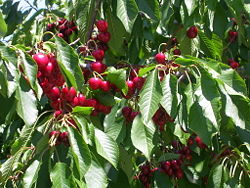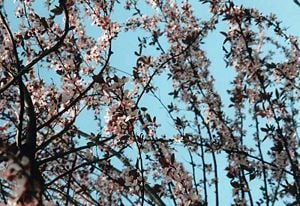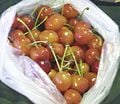Difference between revisions of "Cherry" - New World Encyclopedia
Rick Swarts (talk | contribs) |
Rick Swarts (talk | contribs) |
||
| Line 43: | Line 43: | ||
The [[Sour Cherry]] (''P. cerasus'') is closely related to the wild cherry, ''P. avium'', but has a [[fruit]] which is more [[acid]]ic, and so is useful primarily for cooking and [[jam]] making. The tree is smaller than the wild cherry, growing up to 4-10 m tall, and has twiggy branches, while the crimson to black [[fruit]] is borne on shorter stalks. It also has an ancient origin in human culture. Cultivated sour cherries were selected from wild specimens of ''Prunus cerasus'' and the doubtfully distinct ''P. acida'' from around the [[Caspian Sea|Caspian]] and [[Black Sea]]s, and were known to the [[Greece|Greek]]s in 300 B.C.E. They were also extremely popular with [[Persia|Persians]] and the [[Roman Empire|Romans]] who introduced them into [[Great Britain|Britain]] long before the [[1st century]] AD. In Britain, their cultivation was popularized in the [[16th century]] by [[Henry VIII of England|Henry VIII]]. They became a popular crop among Kentish growers, and by [[1640]] over two dozen named [[cultivar]]s were recorded. In the Americas, [[Massachusetts]] colonists planted the first sour cherry, 'Kentish Red', when they arrived. | The [[Sour Cherry]] (''P. cerasus'') is closely related to the wild cherry, ''P. avium'', but has a [[fruit]] which is more [[acid]]ic, and so is useful primarily for cooking and [[jam]] making. The tree is smaller than the wild cherry, growing up to 4-10 m tall, and has twiggy branches, while the crimson to black [[fruit]] is borne on shorter stalks. It also has an ancient origin in human culture. Cultivated sour cherries were selected from wild specimens of ''Prunus cerasus'' and the doubtfully distinct ''P. acida'' from around the [[Caspian Sea|Caspian]] and [[Black Sea]]s, and were known to the [[Greece|Greek]]s in 300 B.C.E. They were also extremely popular with [[Persia|Persians]] and the [[Roman Empire|Romans]] who introduced them into [[Great Britain|Britain]] long before the [[1st century]] AD. In Britain, their cultivation was popularized in the [[16th century]] by [[Henry VIII of England|Henry VIII]]. They became a popular crop among Kentish growers, and by [[1640]] over two dozen named [[cultivar]]s were recorded. In the Americas, [[Massachusetts]] colonists planted the first sour cherry, 'Kentish Red', when they arrived. | ||
| + | [[Image:Japanese-Cherry.web.jpg|thumb|right|300px|Japanese Cherry (''Prunus serrulata'') in bloom]] | ||
The other species, although having edible fruit, are not grown extensively for consumption, except in northern regions where the two main species will not grow. Some, such as the black cherry, are very popular for making fine furniture and others, such as the Japanese cherry, are popular ornamental trees. | The other species, although having edible fruit, are not grown extensively for consumption, except in northern regions where the two main species will not grow. Some, such as the black cherry, are very popular for making fine furniture and others, such as the Japanese cherry, are popular ornamental trees. | ||
| Line 76: | Line 77: | ||
==Production== | ==Production== | ||
| − | Given the high costs of production, from irrigation, sprays and labor costs, in addition to their proneness to damage from rain and hail, the cherry is relatively expensive. Nonetheless, there is high demand for the fruit. | + | Given the high costs of production, from irrigation, sprays, and labor costs, in addition to their proneness to damage from rain and hail, the cherry is a relatively expensive fruit. Nonetheless, there is high demand for the fruit. |
| − | + | Cherries have a very short fruiting season. In Australia, they are usually at their peak around [[Christmas]] time, in southern Europe in June, in America in June, and in the United Kingdom in mid July, always in the summer season. Annual world production (as of 2003) of domesticated cherries is about 3 million metric tons, of which a third are sour cherries. In many parts of North America, they are among the first tree fruits to ripen; hence the colloquial term "cherry" to mean "new" or "the first", e.g. "in cherry condition." | |
| − | [[ | + | Major commercial cherry orchards in Europe extend from the [[Iberian peninsula]] east to [[Asia Minor]]; they are also grown to a smaller extent north of the [[British Isles]] and southern [[Scandinavia]]. In the [[United States]], most sweet cherries for fresh use are grown in [[California]] and [[Washington]]. Most sour (also called tart) cherries are grown in four states bordering the [[Great Lakes (North America)|Great Lakes]], in [[Michigan]] (the largest producers of cherries among the states), [[New York]], [[Pennsylvania]], and [[Wisconsin]]. However, native and non-native cherries grow well in [[Canada]] ([[Ontario]], and [[British Columbia]]) as well. |
| − | |||
| + | Important sweet cherry cultivars include '[[Bing cherry|Bing]]', 'Brooks', 'Tulare', 'King', and '[[Rainier cherry|Rainier]]'. [[Oregon]] and [[Michigan]] provide light-colored 'Royal Ann' ('Napoleon'; alternately 'Queen Anne') cherries for the [[maraschino cherry]] process. Cultivars of sour cherries include Nanking and [[Evans Cherry]]. | ||
| + | == Importance == | ||
| + | Cherry trees provide food for the [[caterpillar]]s of several [[Lepidoptera]]. See [[List of Lepidoptera which feed on Prunus|List of Lepidoptera which feed on ''Prunus'']]. | ||
| + | As well as the fruit, cherries also have attractive [[flower]]s, and they are commonly planted for their flower display in spring; several of the Asian cherries are particularly noted for their flower display. The Japanese ''[[sakura]]'' in particular are a national symbol celebrated in the yearly [[Hanami]] festival. Many flowering cherry cultivars (known as 'ornamental cherries') have the [[stamen]]s and [[pistils]] replaced by additional [[petal]]s ("double" flowers), so are sterile and do not bear fruit. They are grown purely for their flowers and decorative value. The most common of these sterile cherries is the cultivar 'Kanzan'. | ||
| − | |||
| − | |||
| − | |||
| − | |||
| − | |||
| − | |||
| − | |||
| − | |||
Cherries have been shown to have several health benefits. Cherries contain [[anthocyanin]]s, which is the red pigment in berries. Cherry anthocyanins have been shown to reduce pain and inflammation<ref>''Behav. Brain Res.'' 153(1): 181-188, 12 Aug 2004</ref>. Anthocyanins are also potent antioxidants. Cherries have also been shown to contain high levels of [[melatonin]]<ref>Burkhardt et al., (2002). Detection and Quantification of the Antioxidant Melatonin in Montmorency and Balaton Tart Cherries (Prunus cerasus) [http://dx.doi.org/10.1021/jf010321+ ''J. Agric. Food Chem.'' 49(10): 4898-4902]</ref>. Research has shown that people who have heart attacks have low melatonin levels <ref>''Endocrine'' 38(3): 145-52, 2005</ref>. Besides being an anti-oxidant, melatonin has also been shown to be important for the function of the immune system. Research also indicates that melatonin suppresses [[COX-2]]. There is considerable interest at present in the use of fresh cherries or cherry juice to treat [[gout]] - a painful inflammatory joint condition. <ref>{{cite web|url=http://www.jointenterprise.co.uk/2007/06/cherry-juice-for-gout-pain.html|title=Cherry Juice treatment of Gout Pain}}</ref> | Cherries have been shown to have several health benefits. Cherries contain [[anthocyanin]]s, which is the red pigment in berries. Cherry anthocyanins have been shown to reduce pain and inflammation<ref>''Behav. Brain Res.'' 153(1): 181-188, 12 Aug 2004</ref>. Anthocyanins are also potent antioxidants. Cherries have also been shown to contain high levels of [[melatonin]]<ref>Burkhardt et al., (2002). Detection and Quantification of the Antioxidant Melatonin in Montmorency and Balaton Tart Cherries (Prunus cerasus) [http://dx.doi.org/10.1021/jf010321+ ''J. Agric. Food Chem.'' 49(10): 4898-4902]</ref>. Research has shown that people who have heart attacks have low melatonin levels <ref>''Endocrine'' 38(3): 145-52, 2005</ref>. Besides being an anti-oxidant, melatonin has also been shown to be important for the function of the immune system. Research also indicates that melatonin suppresses [[COX-2]]. There is considerable interest at present in the use of fresh cherries or cherry juice to treat [[gout]] - a painful inflammatory joint condition. <ref>{{cite web|url=http://www.jointenterprise.co.uk/2007/06/cherry-juice-for-gout-pain.html|title=Cherry Juice treatment of Gout Pain}}</ref> | ||
Revision as of 22:08, 3 September 2007
| Cherry | ||||||||||||||||
|---|---|---|---|---|---|---|---|---|---|---|---|---|---|---|---|---|
 Cherries in an orchard in Summerland, British Columbia
| ||||||||||||||||
| Scientific classification | ||||||||||||||||
| ||||||||||||||||
Cherry is the common name for various trees or shrubs comprising the subgenus Cerasus within the genus Prunus of the rose family Rosaceae, a genus that also includes almonds, peaches, plums, apricots and bird cherries. The term also refers to the fleshy fruit (drupe) of these plants, which contains a single stony seed, or to the wood of these plants.
The cherries selected for eating primarily are derived from two species, the wild cherry, P. avium, which has given rise to the sweet cherry to which most cherry cultivars belong, and the sour cherry (P. cerasus), used mainly for cooking and jam making. The black cherry, P. serotina, is popular for construction, and the Japanese cherry, Prunus serrulata, with its beautiful cherry blossoms, is a popular ornamental tree.
Description
Prunus is a genus of plant in the family Rosaceae. Rosaceae is one of the largest families of flowering plants with about 3,400 species, including apples, berries, peaches, plums, cherries, the hawthorn tree, the mountain ash, and many others. The genus Prunus includes the plums, cherries, peaches, apricots, and almonds. There are around 430 species of Prunus spread throughout the northern temperate regions of the globe.
The flowers of Prunus species are usually white to pink, with five petals and five sepals. They are typically borne singly, or in umbels of two to six or more on racemes. The fruit of all Prunus species is a drupe with a relatively large "stone." Leaves are simple and usually lanceolate, unlobed, and toothed along the margin.
The subgenus, Cerasus, is distinguished by having the flowers in small corymbs of several together (not singly, nor in racemes), and by having a smooth fruit with only a weak groove or none along one side. The subgenus is native to the temperate regions of the Northern Hemisphere, with two species in North America, three in Europe, and the remainder in Asia.
The "bird cherries" are generally considered another subgenus, Padus, within the genus Prunus. The type species is the bird cherry, Prunus padus, which sometimes is known as Cerasus padus. The bird cherries are native throughout the temperate Northern Hemisphere and are characterized by having deciduous leaves, flowers 12-30 together on slender racemes produced in late spring well after leaf emergence, and small, sour fruit usually only palatable to birds, hence the name.
The word "cherry" comes from the French word "cerise," which comes in turn from the Latin words cerasum and Cerasus.
Species
There are about 150 species of cherries (Dzhangaliev et al. 2002).
The two most important species in terms of fruit production are the sweet cherry (Prunus avium) and the sour cherry (Prunus cerasus). They are said to be of ancient origin, perhaps coming from Armenia or near the Black Sea and Caspian Sea (Rhind 1865). Herbst (2001) states that the name cherry came from Cerasus, a Turkish town.
The main cherry for eating are cultivars of the sweet cherry, P. avium. This was derived from the wild cherry, P. avium. The stones of wild cherries have been found in deposits at bronze age settlements throughout Europe, including in Britain (Huxley 1992). By 800 B.C.E., cherries were being deliberately cultivated in Turkey, and soon after in Greece (Huxley 1992).
The Sour Cherry (P. cerasus) is closely related to the wild cherry, P. avium, but has a fruit which is more acidic, and so is useful primarily for cooking and jam making. The tree is smaller than the wild cherry, growing up to 4-10 m tall, and has twiggy branches, while the crimson to black fruit is borne on shorter stalks. It also has an ancient origin in human culture. Cultivated sour cherries were selected from wild specimens of Prunus cerasus and the doubtfully distinct P. acida from around the Caspian and Black Seas, and were known to the Greeks in 300 B.C.E. They were also extremely popular with Persians and the Romans who introduced them into Britain long before the 1st century AD. In Britain, their cultivation was popularized in the 16th century by Henry VIII. They became a popular crop among Kentish growers, and by 1640 over two dozen named cultivars were recorded. In the Americas, Massachusetts colonists planted the first sour cherry, 'Kentish Red', when they arrived.
The other species, although having edible fruit, are not grown extensively for consumption, except in northern regions where the two main species will not grow. Some, such as the black cherry, are very popular for making fine furniture and others, such as the Japanese cherry, are popular ornamental trees.
Some of the species of cherries are:
Prunus apetala
Prunus avium (Wild/Sweet Cherry)
Prunus campanulata
Prunus canescens
Prunus cerasus (Sour Cherry)
Prunus concinna
Prunus conradinae
Prunus dielsiana
Prunus emarginata (Bitter Cherry)
Prunus fruticosa
Prunus incisa
Prunus litigiosa
Prunus mahaleb (Saint Lucie Cherry)
Prunus maximowiczii
Prunus nipponica
Prunus pensylvanica (Pin Cherry)
Prunus pilosiuscula
Prunus rufa
Prunus sargentii
Prunus serotina (Black Cherry)
Prunus serrula
Prunus serrulata (Japanese Cherry)
Prunus speciosa
Prunus subhirtella
Prunus tomentosa (Nanking Cherry)
Prunus x yedoensis (Yoshino Cherry)
Production
Given the high costs of production, from irrigation, sprays, and labor costs, in addition to their proneness to damage from rain and hail, the cherry is a relatively expensive fruit. Nonetheless, there is high demand for the fruit.
Cherries have a very short fruiting season. In Australia, they are usually at their peak around Christmas time, in southern Europe in June, in America in June, and in the United Kingdom in mid July, always in the summer season. Annual world production (as of 2003) of domesticated cherries is about 3 million metric tons, of which a third are sour cherries. In many parts of North America, they are among the first tree fruits to ripen; hence the colloquial term "cherry" to mean "new" or "the first", e.g. "in cherry condition."
Major commercial cherry orchards in Europe extend from the Iberian peninsula east to Asia Minor; they are also grown to a smaller extent north of the British Isles and southern Scandinavia. In the United States, most sweet cherries for fresh use are grown in California and Washington. Most sour (also called tart) cherries are grown in four states bordering the Great Lakes, in Michigan (the largest producers of cherries among the states), New York, Pennsylvania, and Wisconsin. However, native and non-native cherries grow well in Canada (Ontario, and British Columbia) as well.
Important sweet cherry cultivars include 'Bing', 'Brooks', 'Tulare', 'King', and 'Rainier'. Oregon and Michigan provide light-colored 'Royal Ann' ('Napoleon'; alternately 'Queen Anne') cherries for the maraschino cherry process. Cultivars of sour cherries include Nanking and Evans Cherry.
Importance
Cherry trees provide food for the caterpillars of several Lepidoptera. See List of Lepidoptera which feed on Prunus.
As well as the fruit, cherries also have attractive flowers, and they are commonly planted for their flower display in spring; several of the Asian cherries are particularly noted for their flower display. The Japanese sakura in particular are a national symbol celebrated in the yearly Hanami festival. Many flowering cherry cultivars (known as 'ornamental cherries') have the stamens and pistils replaced by additional petals ("double" flowers), so are sterile and do not bear fruit. They are grown purely for their flowers and decorative value. The most common of these sterile cherries is the cultivar 'Kanzan'.
Cherries have been shown to have several health benefits. Cherries contain anthocyanins, which is the red pigment in berries. Cherry anthocyanins have been shown to reduce pain and inflammation[1]. Anthocyanins are also potent antioxidants. Cherries have also been shown to contain high levels of melatonin[2]. Research has shown that people who have heart attacks have low melatonin levels [3]. Besides being an anti-oxidant, melatonin has also been shown to be important for the function of the immune system. Research also indicates that melatonin suppresses COX-2. There is considerable interest at present in the use of fresh cherries or cherry juice to treat gout - a painful inflammatory joint condition. [4]
ReferencesISBN links support NWE through referral fees
http://64.233.169.104/search?q=cache:Yv-ZCdA6NBIJ:media.wiley.com/product_data/excerpt/81/04712196/0471219681-1.pdf+Cerasus+species&hl=en&ct=clnk&cd=14&gl=us&client=firefox-aThe Wild Fruit and Nut Plants of Kazakhstan* A. D. Dzhangaliev, T. N. Salova, and P. M. Turekhanova Kazakhstan Academy of Science
herbst
Huxley, A., ed. (1992). New RHS Dictionary of Gardening. Macmillan ISBN 0-333-47494-5.
Rhind, William. 1865. A history of the vegetable kingdom.
External links
- 442898701 88b12bf42e.jpg
Pink Cherry Tree Blossoms
Template:Cherries
Credits
New World Encyclopedia writers and editors rewrote and completed the Wikipedia article in accordance with New World Encyclopedia standards. This article abides by terms of the Creative Commons CC-by-sa 3.0 License (CC-by-sa), which may be used and disseminated with proper attribution. Credit is due under the terms of this license that can reference both the New World Encyclopedia contributors and the selfless volunteer contributors of the Wikimedia Foundation. To cite this article click here for a list of acceptable citing formats.The history of earlier contributions by wikipedians is accessible to researchers here:
- Cherry history
- Prunus history
- Bird_Cherry history
- Bird_cherry_(subgenus) history
- Sour_Cherry history
- Wild_Cherry history
The history of this article since it was imported to New World Encyclopedia:
Note: Some restrictions may apply to use of individual images which are separately licensed.
- ↑ Behav. Brain Res. 153(1): 181-188, 12 Aug 2004
- ↑ Burkhardt et al., (2002). Detection and Quantification of the Antioxidant Melatonin in Montmorency and Balaton Tart Cherries (Prunus cerasus) J. Agric. Food Chem. 49(10): 4898-4902
- ↑ Endocrine 38(3): 145-52, 2005
- ↑ Cherry Juice treatment of Gout Pain.













